Mango: Insect and pest management
Mango: Insect and pest management
Mango hopper
Biology- Egg: Females lay more eggs and nymphs develop faster during the flowering and fruiting period. Eggs hatch in two to three days and nymphs develop between 12 to 20 days
- Nymphs: The nymphs are greenish with black or brown markings, cannot fly and move rapidly on the plant
- Adult: Adult mango leafhoppers are golden-brown or dark brown, wedge-shaped insects about 4-5 mm in length whichlook rather like a small cicada. When disturbed, the adults jump off the plant with a clicking sound, fly a short distance and then quickly resettle on the plant
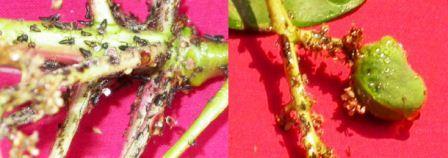
- The wedge shaped nymphs and adult insects puncture and suck sap of tender parts, reducing vigour of plants and particularly destroying the inflorescence and causing fruit drop.
- Heavy puncturing and continuous draining of sap causes curling and drying of infested tissue.
- They also damage the crop by excreting a sweet sticky substance facilitates the development of sooty mould
- Parasitoids: Polynema spp., Gonatocerus sp, Tetrastichus sp
- Predators: Mallada boninensis, Plexippus paykullii
Mango mealy bug
Biology- Eggs: Females lay their eggs directly on the host in a fluted ovisac that is attached to the body of the adult female. Inseminated eggs produce hermaphrodites and un inseminated eggs produce males.
- Nymphs: The first instar nymphs are also called as crawlers, which are mobile.They settle on the plants, start sucking the sap and form the colonies
- Adults: In general they have 4 female instars and 5 male instars, but unlike most other scale insects, the prepupa is quite mobile and although it may have wing buds, the legs and antennae are well developed. Females actually are hermaphrodites that frequently inseminate themselves. Adult males mate with females, but it is not clear if their sperm are used for reproduction.

- The adult bugs are covered with whitish powder and colonize between bark of tree trunk, young shoots and panicles
- The nymphs‟ ascent the trees and settle on inflorescence causing flower drop, affecting fruit set.
- They also excrete honey dew, a sticky substance, which facilitates development of sooty mould
- Predators: Menochilus sexmaculatus, Rodolia fumida, Cryptolaemus montrozieri
Fruit fly
Biology- Egg: Female flies insert eggs under the skin of fruit in clusters of 10 to 50 about 1/25 to 1/8 inch below the fruit surface. The eggs measure about 1/25 by 1/250 inch and are white, elongate, and elliptical. They hatch in 1-1/2 days.
- Maggot: The white maggot is legless, and resembles an elongated cone. The mouth is at the pointed end of the body. There are 3 larval stages, or instars. The third instar is about 2/5 inch long. The entire maggot stage lasts for 11-15 days.
- Pupae: When mature, maggot drop to the ground and pupate in the soil. The puparium is yellowish-brown and seed-like. Adults emerge in about 10 days.
- Adults: Generally, the abdomen has two horizontal black stripes and a longitudinal median stripe extending from the base of the third segment to the apex of the abdomen. These markings may form a "T" shaped pattern, but the pattern varies considerably.Females begin to lay eggs about 8 days after emergence from the puparium. Under optimum conditions, a female can lay more than 3,000 eggs during her lifetime, but under field conditions approximately 1,200 to 1,500 eggs per female is considered to be the usual production. Ripe fruit are preferred for egg laying, but immature ones may be also attacked.

- The female punctures outer wall of mature fruits with the help of its pointed ovipositor and insert eggs in small clusters inside mesocarp of mature fruits.
- On hatching, the maggots feed on fruit pulp and the infested fruits start rotting due to further secondary infection
- Parasitoids: Fopius arisanus, Diachasmi morphakraussi
Inflorescence midge
Biology- Eggs: Eggs are single on floral parts like tender inflorescence axis newly set fruit or tender leaves encircling the inflorescence. The eggs hatch within 2-3 days
- Maggot: The minute maggots penetrate the tender parts where the eggs have been laid and start feeding on them. The mature larvae drop down into the soil for pupation. The larval period varies from 7-10 days, while pupal period varies from 5-7 days
- Pupae: Pupae are yellowish-brown and 1-2 mm long, with male pupae generally smaller than females.
- Adults: Adults are small midges with a wing length of 1.0-1.5 mm. Eye facets are circular, but further apart laterally than in other genera and the tarsal claws are toothed, which is unusual in Cecidomyiini. The ovipositor is protrusible but relatively short and the terminal cerci are fused to form a single lobe. The male gonocoxites are elongate and, unlike those of other Cecidomyiini, have a short mesobasal lobe
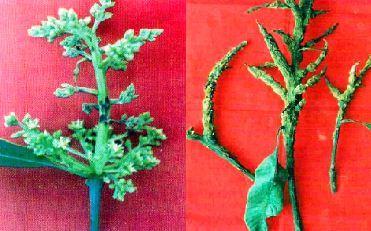
- The larvae tunnel the axis of inflorescence and destroy it completely.
- Damage by E. indicacauses bending and drying of the inflorescences.
- Second attacks starts at fruit setting as young maggots bore into these tender fruitswhich slowly turn yellow and finally drop.
- Third attack is on tender „new leaves encircling inflorescence.
- The most damaging one is first attack in which the entire inflorescence is destroyed.
- The inflorescence shows stunted growth and its axis bends, at the entrance point of larva
- Parasitoids: Tetrastichus sp., Platygaster sp., Systasis dasyneurae, Aprostocetus spp.
Stem borer
Biology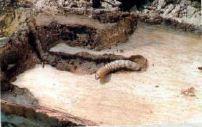 Egg: The eggs are brownish-white, cylindrical, and 6 x 2 mm, with narrowly rounded ends. They are normally placed into an incision, about 25 mm long, cut in the bark by the mandibles.
Egg: The eggs are brownish-white, cylindrical, and 6 x 2 mm, with narrowly rounded ends. They are normally placed into an incision, about 25 mm long, cut in the bark by the mandibles. - Larva: Newly-hatched, first-instar larvae are about 10 mm long. Fully grown larvae may reach 100 mm long, but more commonly reach about 60-80 mm long.The grub is subcylindrical, weakly flattened dorsoventrally, and yellowish-white, with the head dark brown and sclerotized, without obvious legs. The larva is described in detail by Duffy (1968) who also provided a key to separate out all known Oriental cerambycid larvae.
- Pupa: It is robust, about 80 mm long, with some short, reddish setae on labrum and bases of mandibles and antennae.Sides of prothorax with strong tubercle. Basal four abdominal segments with reddish hairs forming transverse interrupted band dorsally, segments five to seven with sparse setae. Apical segment ending with a spine on a strong subvertical acute prominence.
- Adult: Typical cerambycid beetles, recognized by the long antennae reaching to atleast the end of the body and the tarsi, the same on all legs, with apparently four segments excluding the claws, but with the third segment strongly bilobed and almost concealing the very small fourth segment at the base of the true fifth, claw-bearing segment. Length ca 25-55 mm. Covered with grey to yellowish pubescence on a dark brown to pitchy surface. Head held vertically downwards, maxillary palpi tapering apically. Antennae inserted on distinct prominences forming a shallow V-shape on the top of the head.
- Grub tunnels in the sapwood on the trunk or branches
- Grub bore into the sap wood and making irregular tunnels.
- Feeding the vascular tissues
- Interruption of nutrient and water transport on the tissue
- Drying of terminal shoot in early stage
- Frass comes out from several points and sometimes sap oozes out of the holes
- Wilting of branches or entire tree
Bark eating caterpillar
Biology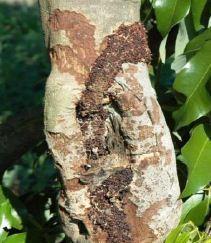 Egg: Adults female emerge in summer and lays 15-25 eggs in clusters under loose bark of the trees spherical eggs, usually singly, eggs hatch in 8-10 days.
Egg: Adults female emerge in summer and lays 15-25 eggs in clusters under loose bark of the trees spherical eggs, usually singly, eggs hatch in 8-10 days. - Larvae: The larval stage is for 10 months. Pupation takes place inside the bore hole. The full grown caterpillar is dirty brown in colour and is about 35-45 mm in length.Larvae makes webs and feeds making zigzag galleries on the wood filled with frass and excreta and later bores inside the wood.
- Pupae: About 10 mm long, it feeds at first in the meristem and later penetrates deep. Pupation takes place inside the bore hole. Pupal stage is 3-4 months
- Adults:
- Male: Head and thorax are rufous. Forewing is pale-rufous with numerous dark-rufous bands of strigae; there is a spot at the end of the cell. The abdomen and hindwings are fuscous.
- Female: Head, thorax and abdomen are ochreous-white. Forewings are ochreous-white with markings as in the male. Hindwings are pale, slightly suffused with fuscous, with numerous obsolescent brown striga.
- Caterpillars bore into the trunk or junction of branches
- Caterpillars remain hidden in the tunnel during day time and come out at night, feed on the bark.
- Larvae construct galleries and move in it.
- Affected plant show dried galleries on the stem and shoots.
- Webbing consists of wooden frass and faecal pellets of larvae hanging outside the tunnel.
- Heavy infestations retard the growth of tree and affect the fruits yield.
Mango nut weevil
Biology- Egg: Eggs are elliptical, about 0.8 mm long and 0.3 mm wide and are creamy-white in colour when freshly laid. They are laid singly in small cavities made by the female in the skin of young fruits. There are reports that eggs may also be laid into inflorescences. The female then covers each egg with a brown exudate and cuts a very small crescent-shaped area (0.3 mm) in the fruit, near the back end of the egg. The wound creates a sap flow, which hardens and covers the egg with a protective coating. Several eggs may be laid in each fruit. Incubation requires 5 to 7 day
- Larvae: Larvae are white grubs with a curved body, brown heads and legless. Newly hatched larvae are extremely slender and elongated and about 1 mm long. Mature larvae are about 17 mm long. After hatching, the larva burrows through the flesh of the fruit and into the seed where they feed until pupation. The development of the larva is usually completed within the maturing seed, but also very occasionally within the flesh.
- Pupae: Pupae are whitish when newly formed, but change to a very pale red colour just before the adult emerges. They are about 8 mm long and 7 mm wide. Pupation takes place in the seed within the stone of the fruit
- Adults: Adults are weevils with a compact body, about 8 mm long. They are usually active at dusk. Adults can fly, but they are not known to be strong fliers. They pretend to be dead when touched or disturbed. Females start egg laying 3 to 4 days after mating, when the fruit is about marble-size. Adult weevils feed on mango leaves, tender shoots or flower buds. They can live for two years.

- Grub makes zigzag tunnels in pulp
- Eats unripe tissue and bore into cotyledons
- Fruit dropping at marble stage
- Oviposition injuries on marble sized fruits.
- Predators: Rhizoglyphus sp, Camponatus spoecophylla, Smaragdina sp.
Shoot gall psyllid
Biology- Eggs: Adult female lays 80-100 eggs on either side of the midrib of a single leaf. Freshly laid egg looked like a rectangular block with rounded corners. The incubation period ranges between 191-211 days.
- Nymphs: Freshly hatched nymph is yellowish in colour, but changed in size and colourwith time. There were six nymphal instars. Each instar moults after duration of about one month except 2nd nymphal instar, which moulted 2-3 weeks after hatching. Only one generation occur in a year. The nymphal period is about five to six months
- Adults: Adult emergence starts from fourth week of February and continued up to third week of March.

- Nymphs emerge during August September and suck cell sap from adjacent buds.
- As a result of feeding, buds develop into hard conical green galls .
- The galls are usually seen during September-October.
- Consequently there is no flowering and fruit setting. Nymphs pass winter inside the galls
- Parasitoids: Tiny parasitic wasp, Inostemma apsyllae
- Predators: Ladybird beele, purplish pirate bug, brown lacewings
Leaf webber
Biology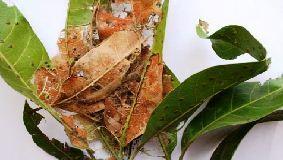 Eggs: The eggs are very small and dull-greenish in colour, and are laid in a scattered manner on the leaves. Adults lays upto 30-50 yellowish green eggs singly near the leaf veins. Egg period is 4 days.
Eggs: The eggs are very small and dull-greenish in colour, and are laid in a scattered manner on the leaves. Adults lays upto 30-50 yellowish green eggs singly near the leaf veins. Egg period is 4 days. - Larvae: There are five larval instars. Larval development takes place in 15 days during July and 33 days in November, when the temperature is comparatively low. After November the larvae hibernate in tough, silken, waterproof cocoons in the soil.
- Pupae: Long brown pupae in white silken cocoons remain attached to leaves. The pupal period lasts 4-5 days, but at 25°C, the pupal period is prolonged to 14-16 days. Temperatures of 40°C and above are detrimental to the pupae and affect adult emergence
- Adult: The head and thorax of the adult moth are grey with a slight olive-green tinge. The abdomen is grey to brownish-grey (fuscous). The forewings are yellowish-white with an olive tinge and slight rufous (reddish-brown) and fuscous (brownish-grey) irroration with black specks at the base and middle of cell. The hindwings are fuscous, the cilia rufous, and underside with indistinct medial curved line. in general, the moth is medium-sized with a wingspan of 31 mm and body length of 14 mm. The male is slightly smaller than the female
- Initially caterpillars feed on leaf surface gregariously by scrapping/Later they make web of tender shoots and leaves together and feed within.
- Several caterpillars may be found in a single webbed up cluster of leaves
- Parasitoids: Brachymeria lasus, Hormius sp. Pediobius bruchicida.
- Predators: Carabid beetle, reduviid bug etc.
Shoot borer
Biology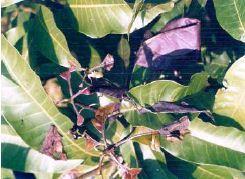 Egg: The eggs were laid in masses on the fruit apex and hatched after 3 to 4 days
Egg: The eggs were laid in masses on the fruit apex and hatched after 3 to 4 days - Larva: Development of the larvae is rapid. The larvae pass through five instars at the rate of approximately one instar each day. The feeding period lasts 5-6 days, after which the caterpillars move from the leaves to search for pupation sites in cracks or crevices in the bark, or in the soil at the base of the tree
- Pupa: The pre-pupal and pupal stages lasted from 2 to 3 and 9 to 14 days, respectively
- Adult: Adult moths are stout grayish brown in colour with wingshaving wavy lines and measure about 17.5 mm with expanded wings. Hind wings are light in colour.
- Larvae bore into young tender leaves during August and freshly hatched caterpillar bore into mid rib.
- After a couple of days, they bore into tender shoots near the growing point tunneling downward, throwing their excreta resulting in dropping of leaves and wilting of terminal shoots
- Parasitoids: Bracon greeni
Crop stage-wise IPM for Mango
To know the crop stage-wise Integrated Pest management practices for Mango, click here.
Source: NIPHM and Directorate of Plant Protection, Quarantine & Storage
Last Modified : 2/13/2020
© C–DAC.All content appearing on the vikaspedia portal is through collaborative effort of vikaspedia and its partners.We encourage you to use and share the content in a respectful and fair manner. Please leave all source links intact and adhere to applicable copyright and intellectual property guidelines and laws.
RELATED ITEMS
Ber Insect and Mite Pests
This topic covers information about Ber Insect and...
Papaya: Insect, Mite and Nematode Pests Management
This topic covers the information related to Insec...
Loquat Insect Pests
This topic provides information about Loquat Inse...
Custard Apple Insect management
This topic covers the information related to insec...
